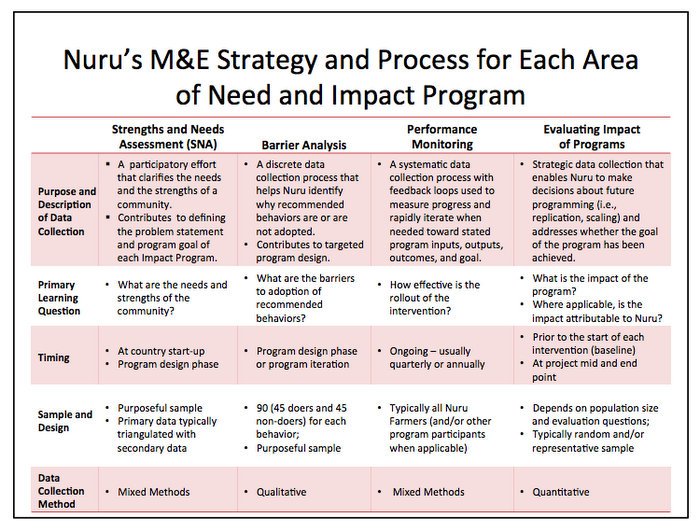Some say, “a picture is worth 1,000 words.” At Nuru, I think that our data collection efforts are sometimes worth more than a million words.
If an evaluation were only as easy as taking a picture of the situation before we start an intervention and then taking follow-up pictures along the way at periodic time points, our work as an M&E team would be a cinch.
However, our work as an M&E team includes systematic, ongoing collection of both qualitative and quantitative data. Therefore, we utilize a mixed methods approach of combining both qualitative and quantitative research in most aspects of our work.
Nuru’s M&E team focuses its work on four main efforts:
- Strengths and Needs Assessments
- Barrier Analysis
- Performance Monitoring
- Evaluating Impact of Programs
 Through each of our data collection processes, we collect either quantitative or qualitative data, or both, depending on the purpose for the data collection effort. For example, with our monitoring system, we seek to determine how effective our interventions are rolling-out in the communities in which we work. Therefore, we collect some quantitative data, like the number of people participating in programs or the repayment rate for Agriculture loans. But, we also collect qualitative data, like when we survey to capture how prepared Nuru Kenya staff feel for the Nuru International staff to exit the project.
Through each of our data collection processes, we collect either quantitative or qualitative data, or both, depending on the purpose for the data collection effort. For example, with our monitoring system, we seek to determine how effective our interventions are rolling-out in the communities in which we work. Therefore, we collect some quantitative data, like the number of people participating in programs or the repayment rate for Agriculture loans. But, we also collect qualitative data, like when we survey to capture how prepared Nuru Kenya staff feel for the Nuru International staff to exit the project.
With the use of GIS software, we can also visualize our impact. Our 2012 Agriculture yield increases are seen below. Simply by viewing the red to green trending of the triangles, we can see that in 2011 Nuru farmers were yielding less than 5 bags before starting to farm with Nuru; and in 2012, farmers yielded more than 10 bags after the Nuru intervention.

Another way we use mixed methods is with triangulation. For our Strengths and Needs Assessment (SNA), Barrier Analyses and with our evaluations, we triangulate our data to increase our confidence in the results. At times, in order to capture a more complete picture of the results of our projects, we strengthen our quantitatively based results by triangulating the data with qualitative data. For example, with our Nuru Kenya Agriculture harvest yield in 2012 (pictures above), we asked farmers who harvested less than 5 bags what had happened to result in such a low, unexpected harvest. Answers ranged from having too many weeds to the farmer giving up on their field for the year. Triangulation helps us to explain our evaluation results more completely and also informs the programs as to why results were or were not as expected.
As we continue to develop and iterate on our M&E systems and processes in Kenya and Ethiopia, our mixed methods approach is becoming more and more vital to us in understanding the complexities of Nuru’s holistic approach and how we are impacting the lives of farmers in rural Africa.

